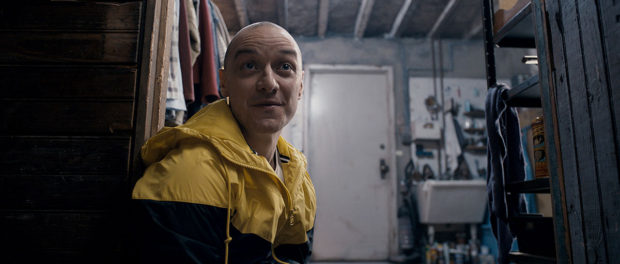Split: Shyamalan’s Signature Thriller
Dissociative identity is not a new subject matter, but certainly not talked about enough. Take that and mix it up with M Night Shyamalan’s abilities to make bone chilling movies and you have Split. Kevin Crumb (James McAvoy) is one of the 23 (towards the end of the film – 24) personalities that are held in captivity by another personality who goes by the name of Dennis. He is conspiring with Patricia (another personality) to convince the others that the Beast is coming and that they will protect them against all evil. The problem is that Dennis isn’t merely fighting for self-preservation. Driven by his fetish to watch naked girls dance, he abducts three teenagers: Claire, Marcia and Casey (played superbly by Anya Taylor-Joy) and this is where Split sets out.
Dennis brings the three girls and locks them up in a basement cell, as one by one Patricia, Hedwig (the young boy personality), and the protector Barry, begin to show themselves, as they take the chair into the light. The idea is that ‘the light’ brings into focus an aspect of Kevin’s personality and Barry (the protective one) decides who gets to be shone in this light. Dennis and Patricia are kept away, for they have deviant and violent tendencies. The first-time Dennis and Patricia’s appearances are apprehended, is when Kevin’s psychiatrist Dr. Fletcher receives an email from Barry, seeking an emergency session with her. Barry travels to Dr. Fletcher’s office, with his latest sketches to share with her, however she questions if it is indeed Barry who is revealing himself. She picks up on some obsessive-compulsive signs, which remind her of Dennis, but she only gently probes Barry if he is who he claims to be.

Split.
We learn about Kevin’s dissociative disorder as Dr. Fletcher speaks to a conference in Paris via Skype, where she provides experience-based evidence of how different personalities co-exist at the same time. Her model of treatment is to allow these personalities to show themselves within the confines of a patient’s safety, and claims that people like Kevin have a way to get better. It is revealed that Kevin is a product of childhood abuse at the hands of his mother, and while the film doesn’t dabble into the demons that haunt Kevin and all of his various personalities, the battle of wills and control between Dennis and Patricia on one side and the rest on the others, is Shyamalan’s masterful crafting of the narrative.
As the three girls try to escape multiple times, they find themselves separated and locked up in different rooms. Casey is the only one who engages with Kevin and while she tries to earn Hedwig’s trust, Claire and Marcia can’t look beyond the psychotic behavior that Dennis depicts and continue to fight an unwinnable battle.
There is a sub-plot: where the paced disclosure of Kevin’s personalities is tied to Casey’s backstory and the abuse she suffered (and continues to) at the hands of her uncles. This stands out as a brutal statement at how our children are forced to grow up at the hands of abusers, molesters and perpetual violence.

Split.
Dr. Fletcher begins to sense that something is amiss and Dennis’s (who is still pretending to be Barry) obsession with the Beast forces her to venture into Kevin’s physical space, putting her directly in harm’s way. She begins to explore how far she can push Dennis, when Casey stumbles upon videos of all 23 personalities, that are stacked on Kevin’s desktop. She watches them chilled to her core, gasping to find her way out.
Split speaks to the deepest and darkest realms of the human brain, its abilities and its fragilities. McAvoy, brilliant in all personalities, playing the Beast summarizes it towards the closing scene, when he says that “We are who we believe we are.”
In signature Shyamalan style, nothing is revealed and we are left guessing how the Beast survived being shot three times by Casey and while only one of his victim’s survived, Kevin is not the one we are left hating.
Split is now playing in theatres.






